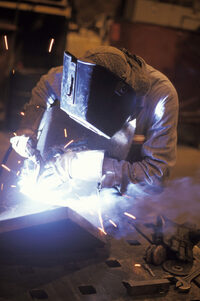 Whether you're a skilled professional who's been using welding machinery since you were knee high to a grasshopper, or a clueless newbie picking up a welder for the first time for a spot of ambitious DIY, welding can be hazardous.
Whether you're a skilled professional who's been using welding machinery since you were knee high to a grasshopper, or a clueless newbie picking up a welder for the first time for a spot of ambitious DIY, welding can be hazardous.
Combining heat, flame, light, dust and noise, there is a lot which can go wrong while welding if you do not exercise the correct precautions and understand the dangers. This blog will outline the most common welding risks and explain how to protect against them:
1. Burns
With a hot torch and flying sparks, burns are one of the biggest welding risks. Head to toe fire-resistant clothing is an essential part of your safety gear, ensuring that if sparks do land on you, they do not come into contact with your skin, or cause your clothing to set alight or melt onto you.
Synthetic fabrics are not suitable for welding work as they are more flammable and prone to melting. Instead opt for clothing made from heavy, natural materials with no fluff and a tight weave – wool and cotton are the best. Ensure that your hair is completely covered with a non-flammable hat or helmet and that you wear long sleeves tucked into gloves to protect your arms and hands.
2. Eye Damage
Your eyes are not only at risk from sparks, they are also at risk from flying debris and retinal damage caused by the brightness of the torch. That's why the right head- and eyewear is so important. When welding arcs burn hot, the can emit very high levels of UV, which can cause retinal damage, cataracts and even blindness.
Welding safety supplier R-Tech Welding advise that to combat the risk from sparks, debris and UV, a combination of goggles (or glasses with side protection) and a welding helmet must be worn. Your welding helmet should have a screen with the correct level of shading to protect against retinal damage. To choose the correct level of shading, look for a visor which you cannot see the welding arc through, then select one shade lighter so that the arc is just visible but not harmful.
3. Hearing Damage
As with all industrial equipment, welders can be very loud, which can pose a risk to your hearing, particularly over the long term. Not all welders will be this loud, but for heavier equipment, ear protection is important. A pair of over the ear headphones with noise-cancelling properties are a wise investment and will protect your ears from sparks and debris.
4. General Risks
From injury to your feet from dropping heavy equipment and materials, to damage to your hands, all the safety basics you'd use for manual tasks apply to welding too. Heavy leather boots with steel toe caps are advisable, as are thick, safety gloves to protect your hands and fingers.